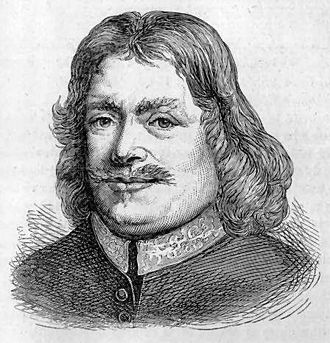 |
| John Bunyan from Wikipedia |
Blake was thoroughly familiar with Bunyan but had some serious theological differences
with him. In the first place Bunyan's masterpiece, Pilgrim's Progress was an allegory;
Blake depreciates allegory:
"[[A Vision of the Last Judgment] PAGE 68]:
The Last Judgment is not Fable or Allegory but Vision
Fable or Allegory are a totally distinct & inferior"
(Erdman 554)
However Blake knew and respected Bunyan in spite of their differences.
Blake died in 1828 and began his illustrations of Pilgrim's Progress in 1824.
Here's Bunyan's Introduction to Pilgrim's Progress:
WHEN at the first I took my pen in hand Thus for to write,
I did not understand That I at all should make a little book In such a mode:
nay, I had undertook To make another, which when almost done, Before I was aware,
this begun. And thus it was: I, writing of the way And race of saints in this our gospel day,
Fell suddenly into an allegory About their journey and the way to glory,
In more than twenty things, which I set down. This done, I twenty more had in my crown;
And they again began to multiply, Like sparks that from the coals of fire do fly.
Nay, then, thought I, if that you breed so fast, I’ll put you by yourselves,
lest you at last Should prove ad infinitum, and eat out The book that I already am about.
Well, so I did: but yet I did not think To show to all the world my pen and ink
In such a mode; I only thought to make I knew not what. Nor did I undertake
Thereby to please my neighbour — no, not I! I did it mine own self to gratify.
Here's Bunyan's Introduction to Pilgrim's Progress:
WHEN at the first I took my pen in hand Thus for to write,
I did not understand That I at all should make a little book In such a mode:
nay, I had undertook To make another, which when almost done, Before I was aware,
this begun. And thus it was: I, writing of the way And race of saints in this our gospel day,
Fell suddenly into an allegory About their journey and the way to glory,
In more than twenty things, which I set down. This done, I twenty more had in my crown;
And they again began to multiply, Like sparks that from the coals of fire do fly.
Nay, then, thought I, if that you breed so fast, I’ll put you by yourselves,
lest you at last Should prove ad infinitum, and eat out The book that I already am about.
Well, so I did: but yet I did not think To show to all the world my pen and ink
In such a mode; I only thought to make I knew not what. Nor did I undertake
Thereby to please my neighbour — no, not I! I did it mine own self to gratify.
John Bunyan , baptised 28 November 1628 – 31 August 1688) was an English writer and preacher best remembered as the author of the religious allegory The Pilgrim's Progress.
In addition to The Pilgrim's Progress, Bunyan wrote nearly sixty titles, many of them expanded sermons.
Bunyan came from the village of Elstow, near Bedford. He had little schooling and at the age of sixteen joined the Parliamentary army during the first stage of the English Civil War. After three years in the army he returned to Elstow and took up the trade of tinker, which he had learnt from his father.
He became interested in religion after his marriage, attending first the parish church and then joining the Bedford Meeting, a nonconformist group in Bedford, and becoming a preacher.
After the restoration of the monarch, when the freedom of nonconformists was curtailed, Bunyan was arrested and spent the next twelve years in gaol as he refused to undertake to give up preaching. During this time he wrote a spiritual autobiography, Grace Abounding to the Chief of Sinners, and began work on his most famous book, The Pilgrim's Progress, which was not published until some years after his release.
Bunyan's later years, in spite of another shorter term of imprisonment, were spent in relative comfort as a popular author and preacher, and pastor of the Bedford Meeting. He died aged 59 or 60 after falling ill on a journey to London and is buried in Bunhill Fields.
The Pilgrim's Progress became one of the most published books in the English language; 1,300 editions having been printed by 1938, 250 years after the author's death.
No comments:
Post a Comment